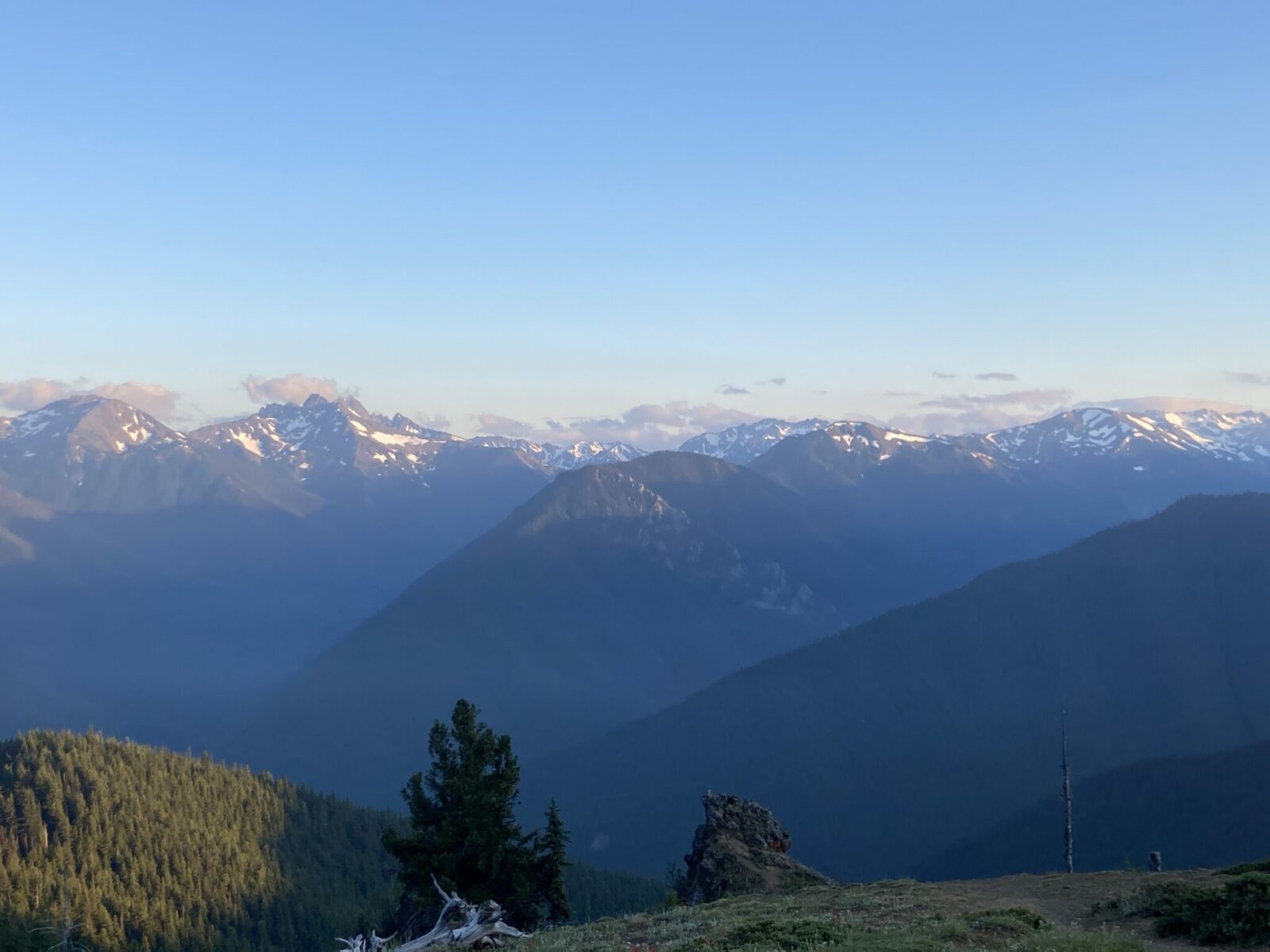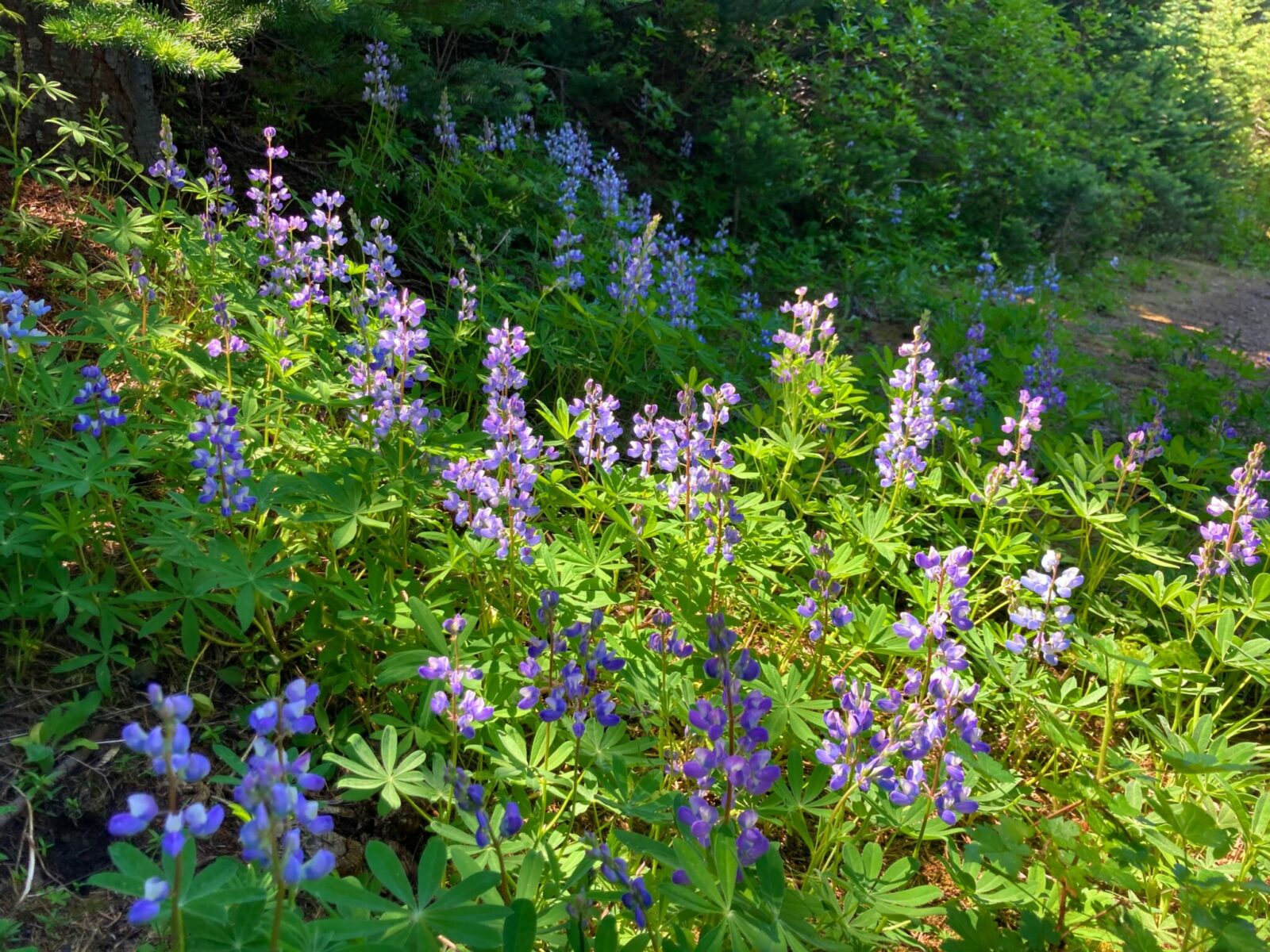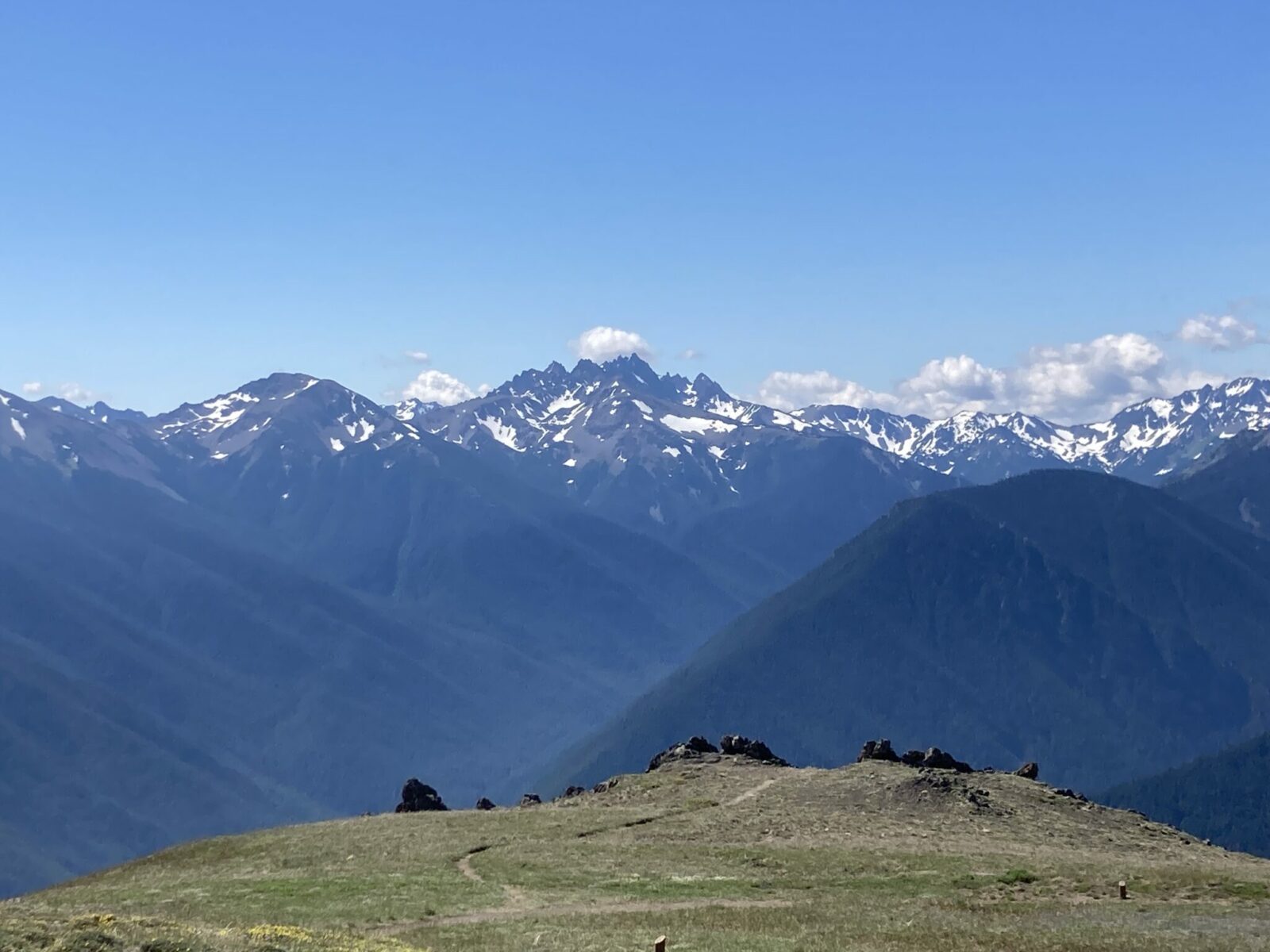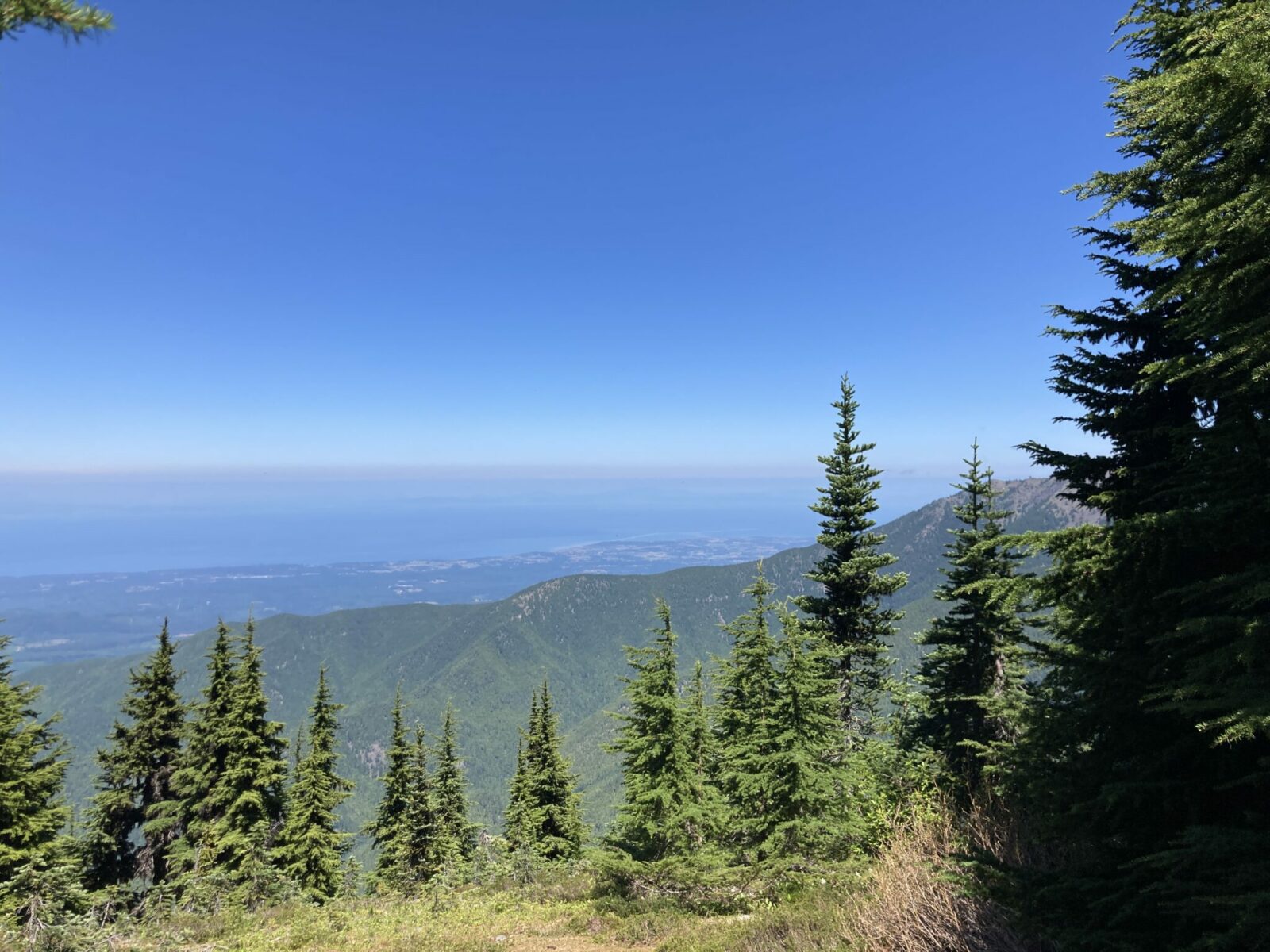Why you should visit Deer Park in Olympic National Park
Last Updated on December 10, 2024
All of Olympic National Park is pretty incredible and there is so much diversity in the park! From towering glacier covered mountains to rugged rocky coastline to impossibly green temperature rainforests and wild rivers, Olympic has so much to see. Deer Park is one of my very favorite places to go in Olympic and I hope to convince you that it’s worth a visit too!
Deer Park is amazing because while you will not be alone here, there are far fewer people than most other parts of Olympic National Park. This makes it an excellent alternative to very busy Hurricane Ridge in the summer. You can find parking even on summer weekend days at the trailhead areas. It has amazing views, incredible wildflowers and wonderful night skies of you decide to camp.
There are a couple of downsides to Deer Park that are important to be aware of before you head up there and reasons there are far fewer people. The 18 mile road from Highway 101 to Deer Park is gravel, steep and extremely narrow, with steep drop offs on one side. The road is in excellent condition and is very smooth, but it’s critical to take it really slow so that you can move to a pull out area if someone comes the other way. Deer Park is also very remote, with almost no cell service and no services, supplies or even water. If you’re ok heading into a remote area with no services and can commit to a slow but beautiful drive, then Deer Park is perfect for you.
The main activities in Deer Park are checking out the view from your car (there are are a couple places to do this, see below), hiking and camping, in addition to any contemplative activities you might be into like drawing, painting, writing, reading or picnicking in beautiful places.
Deer Park is the homeland of the S’Klallam People.
Accessibility: Deer Park has an ADA accessible pit toilet in the campground. The roads are in good condition for walking as well as driving. The trails are well maintained, but do have some rocks, roots and steps. There are no emergency services, food or water at Deer Park so make sure to bring anything you need with you.
Cell Service: There is basically no cell service here. You might be able to squeeze out one bar on the summit of Blue Mountain, or along the Obstruction Point Road trail here and there.
Passes Needed: You will need pay the Olympic National Park entrance fee, $30 per vehicle for 7 days. You’ll need to buy an America the Beautiful Pass in advance or pay the entrance fee in Port Angeles.
Dog Friendly: Leashed dogs are welcome on the road and in the campground, however dogs are not permitted on any of the hiking trails.
Related: Three day Olympic National Park Itinerary
How to get to Deer Park in Olympic National Park
The only way to get to Deer Park is to drive. I would not recommend riding a bike here as it would be really miserable on the narrow gravel road with traffic going by in the one lane! From Highway 101, turn on Deer Park Road at the Cinema and Rest Area just east of Port Angeles.
Once on the road, you’ll head first by some houses and then more forest and after about 9 miles at the boundary of Olympic National Park the road becomes gravel and starts climbing steeply. The next 9 miles are slow but spectacular. You’ll be on a very narrow, very winding gravel road with a steep drop off one one side. Drive slowly so you can use the pullouts if someone comes the other way.
When you arrive in the Deer Park area, you’ll first pass a spur road that goes to the Ranger Station and the Obstruction Point trailhead. About a half mile further on at a hairpin turn, the campground is on the right. If you continue around the switchback the road dead ends at the parking area on Blue Mountain.
Deer Park is about a two hour drive from the Kingston or Bainbridge Ferry Terminal and about an hour drive from Port Angeles.
When is the best time of year to go?
From the 1930s till the 1950s, Deer Park was one of the best ski areas in the Pacific Northwest! It was plowed and full of people every winter weekend. I so wish I had been alive then to experience it. In the late 1950s the ski area was moved to nearby Hurricane Ridge and Deer Park was closed for the winter.
Today, the road is only open from sometime in June through sometime in October. Check Olympic National Park’s road conditions to determine if the road is open at the time of your visit.
I recommend checking the forecast and saving your trip for a clear day when you can enjoy the views which are really the highlight of a visit here!
Views at Deer Park

The views at Deer Park are the number one highlight of visiting here! If you go for a hike or stay overnight in the campground you’ll get even more time with the views and wildflowers, but if you are not a hiker or camper you should still absolutely drive up to Deer Park to see the incredible views! The best two places for good views that you can see from your car are:
- The Campground – Pull over in a wide spot in the campground and take in the views over the Gray Wolf Valley and towards the peaks of the Olympic Mountain Range. Excellent chance of seeing deer wandering around the campground as well. You’ll also see tons of wildflowers and birds.
- Blue Mountain Parking Lot – if you’re up for a short hike (1/2 mile loop), head up to the summit of Blue Mountain (more on this below), but you can also see a wonderful view from the small parking area. This view is over the Strait of San de Fuca, Vancouver Island, Port Angeles, Sequim and the whole north part of the Salish Sea!
Camping at Deer Park

The Deer Park Campground is my favorite car camping campground in Washington State! It’s absolutely stunning with it’s mountain views, wildflowers and birds all around. It’s a tiny campground with only 14 sites and nothing else nearby so you really get away from it all. There are no services here so make sure to bring everything with you that you need for camping, including water and firewood (unless there’s a burn ban). It has a pit toilet in each loop and each site has a firepit and picnic table. Some of them even have three sided cabin structures with bunks!
This campground is first come first served, which means you might get there and not be able to find a spot. It’s important to always have a backup plan if there are no spots available. There does tend to be turnover in the campground every day, so if you arrive in the morning you’ll increase your chances of finding a free spot.
If you’re a fan of astronomy, stargazing or night photography, make sure to bring all your equipment here because the night sky is absolutely incredible.
Hikes in the Deer Park area of Olympic National Park

The Deer Park Area is a hiker’s paradise and a weekend of hiking here is a must do for every hiker, either visitor or local! The trailheads here connect to several other trail systems so you can grab a map and make up your own hike! The trails are much less crowded than other parts of the park and finding parking is beautifully simple. A few favorite hikes here include:
Blue Mountain Summit – Rainshadow Loop Trail

Blue Mountain is a half mile loop with about a hundred feet of elevation gain from the parking area below the summit. This is the shortest summit hike I know of in Washington and it’s also one of the most incredible views in all of Olympic National Park!
On Blue Mountain, you’ll be above the trees in open rocky meadows full of wildflowers and the loop takes you to views in literally every direction. This area is in the rain shadow of the Olympic Mountains and is much drier than many other areas of the Olympic Peninsula and Western Washington.
Obstruction Point Trail to Maiden Peak

The Obstruction Point Trail goes from the Deer Park Ranger Station all the way to Obstruction Point near Hurricane Ridge. The entire trail is 8 miles one way which would make for a very long day hike! Fortunately this entire trail is beautiful and you can go any length you like along it and return to Deer Park.
I recommend going to the meadow (5 miles round trip with 1600 feet of elevation gain) or to Maiden Peak (9 miles round trip with 2000 feet of elevation gain). Either way, or any other length along the trail, will give you some great views and gorgeous wildflowers so you really can’t go wrong here!
The first half mile from the Ranger station goes downhill through the forest on a very even and smooth trail. After about half a mile the trail starts climbing and at times it is quite steep with some loose rocks. Once you get through that section you’ll go through a series of wildflower meadows with nice views of the Olympic Mountains as well as views towards Sequim, Port Angeles and Victoria.

The trail is very smooth through the meadows and this makes for a good turnaround spot. If you want to go further, for more climbing and more views, continue up up up to Maiden Peak where the 360 degree views start to come in.
However far you go make sure to decide on a turn around time to make sure you get back and don’t end up with a much longer hike than you planned by not paying attention to how far you go!
Deer Ridge Trail

Another gorgeous view and wildflower hike at Deer Park (see a theme??) is Deer Ridge. This is another choose your own adventure hike that you can take as long or short as you want!
This hike starts in the campground near the walk in sites and is signed for the Three Forks Trail. I’m not a fan of the Three Forks trail as it goes very steeply down into a valley and then your legs are sooooo tired before you have to climb back out! If that’s your thing though, it’s absolutely beautiful, so go for it.
For the rest of us, the mellow ridge hike offers awesome views without too much climbing. From the trailhead, cross a meadow and then follow the trail in and out of the forest and along wildflower meadows with gorgeous views of the Olympic Mountains. In a short distance, you’ll come to the junction with the Three Forks trail, which goes down to the right. To keep it mellow, keep going straight and after about a mile and a half from your car, you’ll come to the park boundary and the trail begins to go steeply downhill towards Slab Camp.
You can go as far as you like here, but for a mellow outing of three miles round trip with a couple hundred feet of elevation gain, turn around when the trail starts to go steeply downhill near the park boundary.










